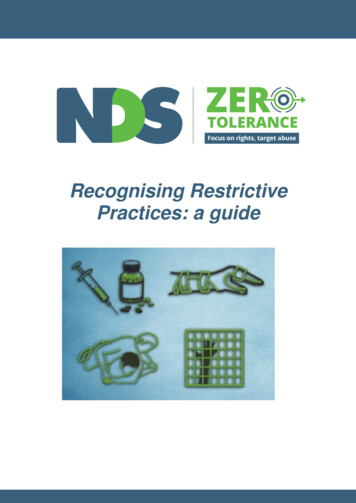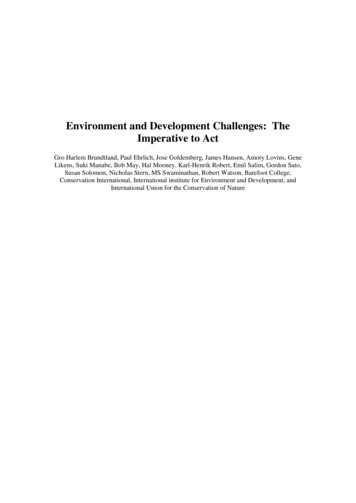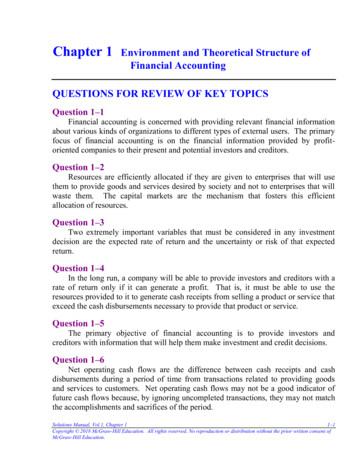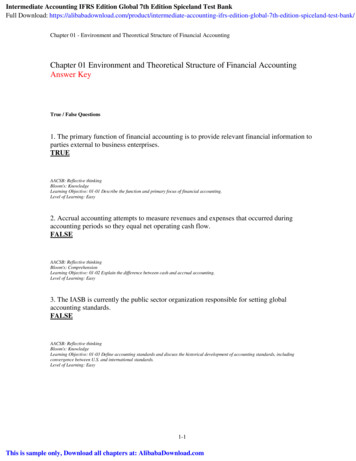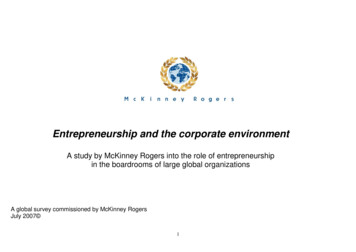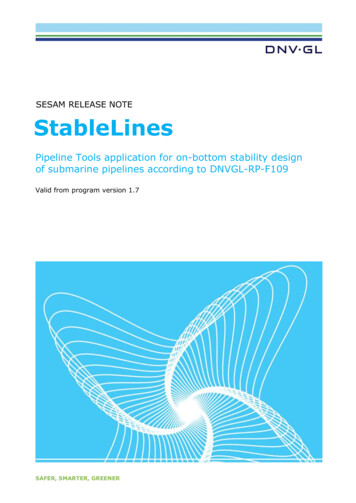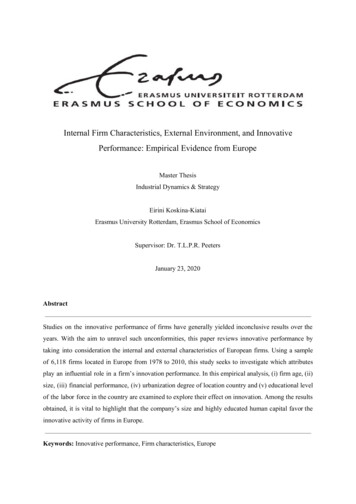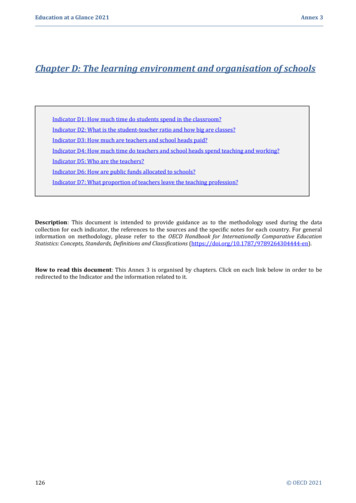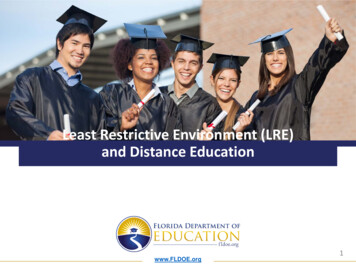
Transcription
Least Restrictive Environment (LRE)and Distance Educationwww.FLDOE.org1
2019-20 LEAs in Floridawww.FLDOE.org2
2020-21 LEAs in Florida67 TraditionalSchool Districts2 Specialty LEAs(FSDB and FLVS)4 University LabSchools(FAU, FSU, FAMU and UF)4 Charters(Lake Wales, South Tech,UCP and *KIPP)TOTAL77 LEAs*New for 2020-21www.FLDOE.org3
LRE Requirements and Considerationswww.FLDOE.org4
Important Reminders for Providing FreeAppropriate Public Education (FAPE) Emergency Order 2020-EO-06 specifically addresses students with disabilities(SWDs) in Section (I)(d) of the requirements for Florida’s reopening 1/urlt/DOE-2020-EO-06.pdf The Individuals with Disabilities Education Act (IDEA) (see 34 C.F.R. § 300.114)requires LEAs to give SWDs equal access to the same opportunities andprograms that are offered to students without disabilities. LRE is determined by the student’s Individual Educational Plan (IEP) team.Students are to be placed in the regular education environment and are onlyremoved from this setting if the “nature or severity of the disability is such thateducation in regular classes with the use of supplementary aids and servicescannot be achieved satisfactorily.”www.FLDOE.org5
Important Reminders for Providing FAPE(continued) While the COVID-19 pandemic has not changed the individual’s rightto LRE, it has changed how the general education system operates.These operational changes require school systems, in conjunctionwith IEP teams, to determine how they will maintain each individualstudent’s LRE in the new context in which they are operating. Documentation on the provision of FAPE for each student is requiredto prove compliance with state and federal law.www.FLDOE.org6
IEP Team Decisions for Distance Learning If the IEP team has determined there are no barriers to astudent’s participation in distance learning option and allrelated services can be provided, there are no changes neededin the student’s IEP. If the IEP team determines that the child’s participation in theparent’s chosen option would not result in the provision ofFAPE, it should be noted in the IEP and the district is required toprovide prior written notice consistent with the requirements of34 C.F.R. § 300.503. (e.g., Student participates in distancelearning and some related services are provided virtually andsome at school site, but parent refuses to make child availablein person.) Changes to the IEP can be accomplished by convening an IEPteam meeting or by the parent and school agreeing in writing(34 C.F.R. § 300.321) to amend the IEP without a meeting.www.FLDOE.org7
IEP Reminders All services on a student’s IEP must be provided. No waiver of the requirement to provide services has been provided ateither the state or federal level. While the majority of services, includinginstruction and related services, can be provided virtually, professionalnursing services cannot. Arrangements must be made to provide theseservices in person unless the parent will not allow the nurse to enter thehome or prefers to provide the required services themselves. In these cases, written notice consistent with 34 C.F.R. § 300.503 must beprovided and an amendment must be made to the IEP, removing theservices or stating that the services will be provided only when the studentis in the brick-and-mortar environment.www.FLDOE.org8
Agreement Cannot be Reached RegardingPlacement District must provide prior written notice of decision thatmeets all the requirements of 34 C.F.R. § 300.503 and Rule6A-6.0331, Florida Administrative Code (F.A.C.). Per USDOE OSEP’s Q&A released June 30: “The Departmentbelieves that it would be appropriate to consider factorssuch as the closure of public and school buildings andfacilities, social distancing, and other health-related ordersduring the pandemic in determining what constitutes areasonable time. Nevertheless, public agencies [schooldistricts] should make every effort to ensure that writtennotice is provided as soon as possible prior to theproposed or refused action.”www.FLDOE.org9
Written Notice of Refusal Must Include: (1) A description of the action proposed or refused by the agency/district; (2) An explanation of why the district proposes or refuses to take theaction; (3) A description of each evaluation procedure, assessment, record, orreport used as a basis for the proposed or refused action; (4) A statement that the parents of a child with a disability have protectionunder the procedural safeguards of this part and, if this notice is not aninitial referral for evaluation, the means by which a copy of a descriptionof the procedural safeguards can be obtained; (5) Sources for parents to contact to obtain assistance inunderstanding; (6) A description of other options that the IEP Team considered and thereasons why those options were rejected; and (7) A description of other factors that are relevant to the district’s proposalor refusal.Per 34 C.F.R. § 300.503www.FLDOE.org10
Data Reporting for LREwww.FLDOE.org11
Educational Environments1. Inside the regular classroom 80 percent or more ofthe day2. Inside the regular classroom no more than 79 percentof the day but no less than 40 percent of the day3. Inside the regular classroom less than 40 percent ofthe day4. Separate school (public or private school for SWDs)5. Residential facility (public or private school for SWDs)6. Homebound or hospital7. Correctional facilities8. Parentally placed in private schoolwww.FLDOE.org12
Least Restrictive Environment (LRE) All state educational agencies (SEAs) are required to submitdata on LRE placement by April 1, 2021. All local educational agencies (LEAs) are required to submitdata via the Student Information System (SIS) during Survey 2using date certain, which is October 9, 2020. SWDs ages 6 – 21, State Performance Plan (SPP) Indicator 5**New** This now will include those students who are 5 yearsold and in kindergarten. Early Childhood Settings for children with disabilities ages 3 – 5,SPP Indicator 6 **New** This will now exclude those studentswho are 5 years old and in kindergarten.www.FLDOE.org13
2020-21 Survey 2 dates for LRE reporting October 5-9FTE Survey 2 Week October 16Survey 2 is due October 12-30State Processing (data qualityreports will be made availableafter this date) December 15Close of Survey 2 and due datefor all correctionswww.FLDOE.org14
Required Formats and Data ElementsAge is determinedby comparing thebirth date with theFriday of surveyweek.* Indicates key fieldsSource: 2020-21 FDOE Database Manualswww.FLDOE.org15
Codes for Students Ages 3-5(excluding K who are age 5)Florida Department of Education, Information Database Requirements Volume I:2020-21 1-117525.pdfwww.FLDOE.org16
SPP Indicator 6A(majority of ESE services are provided in theclassroom with at least 50 percent SWDs)The “K” code is the only code that is used for 6AFor example: Child is in public or private school for voluntary pre-kindergarten(VPK) and has an IEP that states 1 hour language therapy. Thespeech language pathologist (SLP) is “pushed in” to provide therelated services to the child. Full-time child with an IEP in a VPK classroom with a certifiedteacher for a pre-kindergarten ESE course code.The “M” code is not used because services are “pulled out”For example: Child is in public or private school for VPK and has an IEP that states1 hour language therapy. The child is “pulled out” to receive servicesby the SLP.www.FLDOE.org17
SPP Indicator 6B(students placed in a separate classroom, schoolor facility with 50 percent or more SWDs)The “B” code is used for a residential facilityFor example: Residential school or residential medical facility on an in-patient basisThe “L” code is used for a separate class or separate schoolFor example: Self-contained classroomThe “J” code is used for children who do not attend an early childhood programbut receive all of their related services for special education from a clinician orservice provider.For example: Parent or guardian transports the child for speech to school, library orother setting in the school or clinician’s office.www.FLDOE.org18
Codes for Students 6-21(including K students who are age 5)Florida Department of Education, Information Database Requirements Volume I: rlt/2021-117525.pdfwww.FLDOE.org19
Two Key Data Elements in the Calculation of LRE Time with Non-Disabled Peers:The total amount of time that SWDs are with non-disabled peers,including time with school and work place peers. This should be reportedin minutes per week. Include class time, lunch, recess and time betweenclasses if this time is spent with non-disabled peers. Time, Total School Week:The total amount of time a student with a disability is scheduled to attendschool each week. Time should be reported in minutes per week. Allscheduled time, i.e., class time, recess, lunch, and time between classesmust be included in the total.www.FLDOE.org20
LRE and Federal ReportingSWDs Ages 6 – 21 (including 5 year old K)Federal ReportingAuthorityDescriptionIDEA Environment CodeRegular ClassroomEdFactsSPP Indicator 5AInside regular class80% or more of the dayZTime With Non-DisabledPeers divided by Time,Total School WeekResource ClassroomEdFacts only(BEESS Indicator)Inside regular class40%-79% of the dayZTime With Non-DisabledPeers divided by Time,Total School WeekSpecial ClassroomEdFactsSPP Indicator 5BInside regular class 40% of the dayZSeparate SchoolEdFactsSPP Indicator 5CD, F and HCorrectional Facilities(DJJ, county jails andstate prisons)Parentally Placed inPrivate SchoolsEdFacts only Separate school Residential facility Homebound/HospitalCorrectional facilitiesTime With Non-DisabledPeers divided by Time,Total School WeekBy the IDEA EnvironmentalCodeCBy the IDEA EnvironmentalCodePrivate schools, McKayScholarship recipients,and home educationprogramsPBy the IDEA EnvironmentalCodeCategoryEdFacts onlywww.FLDOE.orgHow Placement isDetermined21
IDEA Data Center Guidance onDistance Learning and LREBull, B., Thacker, C., Crain, D., and O’Hara, N. (2016, December). OnlineLearning and IDEA Educational Environments (Ages 6-21): DeterminingEducational Environments for Students With Disabilities (Version 1.0).IDEA Data Center. Rockville, MD: s/media/documents/202007/Ed Environments White Paper.pdfwww.FLDOE.org23
General ConsiderationsWhen determining the educational environment ofindividual SWD taking online courses, consider:a) If other students without disabilities are taking thecourse;b) Where the course is held; andc) If the SWD has been placed in a less restrictive setting bythe IEP team when engaged in online learning.www.FLDOE.org24
Generally, when SWDs participate in online learning in a course open to studentswith and without disabilities—that is, the course is unrelated to the student’sdisability—that online learning time should be considered time inside the regularclassroom. Generally, when students with disabilities spend time in an online learningenvironment with no specific requirement as to the location for participation—that is, students may participate in online learning at any location at theirdiscretion to complete the class or program requirements—that online learningtime should be considered time inside the regular classroom. If there is a prescribed location where students must be while participating inonline learning, whether this time is considered inside the regular classroom isbased on the actual setting and whether the students who are participating inthe prescribed location are students with or without disabilities. If both studentswith and without disabilities are enrolled in the online course, personnel shouldrefer to state policy/guidance as to what constitutes the makeup of students withand without disabilities in a “regular classroom.”www.FLDOE.org25
Online learning course content does not determine the educationalenvironment. The time in the online learning environment is determined to betime inside the regular classroom—or not—based on both the location whereSWDs access the online course and the characteristics of other students whoare, or may be, participating in the course. When students spend more than 50 percent of their school day in a separateschool for SWDs, regardless of their participation in other locations that maybe less restrictive, the educational environment for the students is separateschool. The same is true for residential facilities. Time spent in online learningfor students in those placements would not change the more restrictiveeducational environment categories established by the IEP team.www.FLDOE.org26
For students placed in homebound or hospital settings, correctional facility, orparentally placed in a private school, participation in online learning does notchange these more restrictive educational environments that have beenestablished by the IEP or services plan. Students in these settings may participate in online learning, but time spent inonline learning, even if that online learning time would be considered a regularclass environment based on information shared in this document, would notchange their educational environment for reporting purposes. They would beclassified as being in homebound or hospital settings, correctional facility, orparentally placed in private school.www.FLDOE.org27
Bull, B., Thacker, C., Crain, D., and O’Hara, N. (2016, December). Online Learning and IDEA Educational Environments (Ages6-21): Determining Educational Environments for Students With Disabilities (Version 1.0). IDEA Data Center. Rockville, MD:Westat. /documents/2020-07/Ed Environments White Paper.pdfwww.FLDOE.org28
Florida-Specific ConsiderationsOnline and in-person classes have the sameenvironmental definitions.www.FLDOE.org29
Learning Models The structure of the learning models may differ depending onapproved district reopening plans. Synchronous Live instruction for all courses occurring at the same time (online or inperson) Asynchronous Not all instruction for the course occurs at the same time Recorded instruction for students to access at a later time than the live session. Students check in with teacher online, but work on their own assignments in theirown time.www.FLDOE.org30
General Considerations for Distance LearningTime Inside the “Regular Class” Course content does not determine the educational environment. SWD participates in distance learning. If the SWD spends 80 percent or more of their school day in a classthat has SWD and non-SWD, the environment would be “regularclass.” Access courses for SWDs are “setting neutral.” If the class contains bothSWDs and non-SWDs, the time would be considered time with nonSWD inside the regular classroom, regardless of the course number. The exception to this is students who are already in a separateenvironment, e.g., hospital homebound, residential center, etc. as theyremain in “separate environment” regardless of time spent with nonSWDs.www.FLDOE.org31
General Considerations for Distance LearningTime Inside the “Resource Class” SWD participates in distance learning. If the SWD spends 40-79 percent of their schoolday in a regular class, the environment would be“resource class.”www.FLDOE.org32
General Considerations for Distance LearningTime Inside the “Separate Class” SWD participates in distance learning. If the SWD spends less than 40 percent of theirschool day in a regular class, the environmentwould be “separate class.”www.FLDOE.org33
Considerations for Related Services If a related service provider joins an online generaleducation class and works in a small group thatincludes SWDs and peers without disabilities, thattime would be counted toward time with theirnon-disabled peers. If a related services provider works with an SWDindividually or in a small group setting with allSWDs, that time would not be counted as timewith their non-disabled peers.www.FLDOE.org34
Key Consideration: What are studentswithout disabilities doing? If SWDs in distance learning are doing what their nondisabled peers are doing in the same class, e.g.,asynchronous online learning, the time is counted as time inregular class with non-disabled peers. Florida Virtual School counts LRE this way. The exception to this is students who are already in aseparate environment, such as hospital homebound orresidential center.www.FLDOE.org35
Scenarios for Z Code Studentswww.FLDOE.org36
How to Calculate LRETime With Non-Disabled PeersX 100Time, Total School Week Percent of time with peerswithout disabilitiesStep 1: Determine Time, Total School Week Use your school’s master bell schedule. This amount wouldapply to all students no matter the location of the studentenrolled in your school.Step 2: Determine Time With Non-Disabled Peers Calculate the number of minutes per week the student isreceiving ESE services or is in class with only SWDs. Subtract this amount from the Time, Total School week.Step 3: Calculate Percent of time with Non-Disabled Peers Divide Total Time with Non-Disabled Peers by Time, TotalSchool Week. Multiply by 100.Source: Florida's SPP/APR Calculation Guidewww.FLDOE.org37
Scenario #1 – Brick and MortarA student with a disability participates with their peers without disabilities in abrick-and-mortar school for all of their classes, except math. This includes specialarea, lunch and also ELA using a virtual platform. The student is pulled out forinstruction in math for 60 minutes daily with only SWDs in a virtual platform. Theminutes in the school week are 1,650 minutes.Educational Environment Code ZTime, Total School Week 1,650 minutesTime with Non-Disabled Peers Time spent with only SWD Math (60 minutes X 5 days) 300 Time with Non-Disabled Peers 1650 – 300 1350Percent LRE (1350 divided by 1650) X 100 81.8 percentEducational environment would be considered “Regular Classroom.”www.FLDOE.org38
Scenario #2 – Distance LearningA student with a disability attends school virtually with their non-disabledpeers. The SLP provides small group support for ELA for 20 minutes per day ina virtual general education classroom made up of SWD and students withoutdisabilities. The special education teacher provides small group support toonly SWDs for 30 minutes in math each day. The minutes in the school weekare 1,650 minutes.Educational Environment Code ZTime, Total School Week 1,650 minutesTime with Non-Disabled Peers Time spent with only SWD Math (30 minutes X 5 days) 150 Time with Non-Disabled Peers 1650 – 150 1500Percent LRE 1500 divided by 1650 X 100 90 percentEducational environment would be considered “Regular Classroom.”www.FLDOE.org39
Scenario #3 – Distance LearningA student with a disability, on access points, participates in virtual instruction with a generaleducation teacher and a special education teacher that includes students without disabilitiesfor science and social studies. The SWD also attends special area or electives virtually 30minutes with their peers without disabilities. The special education teacher providesinstruction with only SWDs virtually daily for ELA (90 minutes) and math (60 minutes). The SLPprovides 30 minutes of speech therapy twice a week in a virtual setting with only SWDs. Theminutes in the school week are 1,650 minutes.Educational Environment Code ZTime, Total School Week 1,650 minutesTime with Non-Disabled Peers Time spent with only SWD ELA and Math (90 60) minutes X 5 days 750 SLP (30 minutes X 2 days) 60 750 60 810 Time with Non-Disabled Peers 1,650 – 810 840Percent LRE (840 divided by 1,650) X 100
§ 300.503. (e.g., Student participates in distance learning and some related services are provided virtually and some at school site, but parent refuses to make child available in person.) Changes to the IEP
